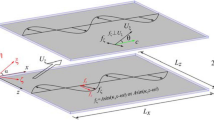Abstract
Turbulent control and drag reduction in a channel flow via a bidirectional traveling wave induced by spanwise oscillating Lorentz force have been investigated in the paper. The results based on the direct numerical simulation (DNS) indicate that the bidirectional wavy Lorentz force with appropriate control parameters can result in a regular decline of near-wall streaks and vortex structures with respect to the flow direction, leading to the effective suppression of turbulence generation and significant reduction in skin-friction drag. In addition, experiments are carried out in a water tunnel via electro-magnetic (EM) actuators designed to produce the bidirectional traveling wave excitation as described in calculations. As a result, the actual substantial drag reduction is realized successfully in these experiments.
Similar content being viewed by others
References
Xu C X, Deng B Q, Huang W X, et al. Coherent structures in wall turbulence and mechanism for drag reduction control. Sci China-Phys Mech Astron, 2013, 56(6): 1053–1061
Sun Z S, Ren Y X, Larricq C. Drag reduction of compressible wall turbulence with active dimples. Sci China-Phys Mech Astron, 2011, 54(2): 329–337
Kim J, Moin P, Moser R. Turbulence statistics in fully developed channel flow at low Reynolds number. J Fluid Mech, 1987, 177: 133–166
Ge M W, Xu C X, Cui G X. Transient response of Reynolds stress transport to opposition control in turbulent channel flow. Sci China-Phys Mech Astron, 2011, 54(2): 320–328
Huang L P, Fan B C, Dong G. Turbulent drag reduction via a transverse wave traveling along streamwise direction induced by Lorentz force. Phys Fluids, 2010, 22(1): 015103
Berger T W, Kim J, Lee C, et al. Turbulent boundary layer control utilizing the Lorentz force. Phys Fluids, 2000, 12(3): 631–649
Lee C, Kim J. Control of the viscous sublayer for drag reduction. Phys Fluids, 2002, 14(7): 2523–2529
Du Y Q, Symeonidis V, Karniadakis G E. Drag reduction in wall-bounded turbulence via a transverse travelling wave. J Fluid Mech, 2002, 457: 1–34
Satake S, Kasagi N. Turbulence control with wall-adjacent thin layer damping spanwise velocity fluctuations. Int J Heat Fluid Flow, 1996, 17(3): 343–352
Pang J, Choi K S. Turbulent drag reduction by Lorentz force oscillation. Phys Fluids, 2004, 16(5): 35–38
Mei D J, Fan B C, Huang L P, et al. Drag reduction in turbulent channel flow utilizing spanwise oscillating Lorentz force (in Chinese). Atca Phys Sin, 2010, 59(10): 6786–6792
Mei D J, Fan B C, Chen Y H, et al. Experimental investigation in turbulent channel flow utilizing spanwise oscillating Lorentz force (in Chinese). Atca Phys Sin, 2010, 59(12): 8335–8342
Du Y Q, Karniadakis G E. Suppressing wall-turbulence by means of a transverse traveling wave. Science, 2000, 288: 1230–1234
Xu P, Choi K S. Boundary layer control for drag reduction by Lorentz forcing. In: Proceedings of Flow Control and MEMS. Berlin: Springer, 2007. 259–265
Canuto C, Hussaini M Y, Quarteroni A, et al. Spectral Methods in Fluid Dynamics. New York: Springer-Verlag, 1988. 201–212
Huang W X, Xu C X, Cui G X, et al. Mechanism of drag reduction by spanwise wall oscillation in turbulent channel flow (in Chinese). Chin J Theor Appl Mech, 2004, 36(1): 24–30
Huang L P, Fan B C, Dong G. Turbulent drag reduction via a streamwise traveling wave induced by spanwise wall oscillation (in Chinese). Chin J Theor Appl Mech, 2011, 43(2): 277–281
Zhou J, Adrian R J, Balachandar S, et al. Mechanisms for generating coherent packets of hairpin vortices in channel flow. J Fluid Mech, 1999, 387: 353–396
Choi K S, Clayton B R. The Mechanism of turbulent drag reduction with wall oscillation. Int J Heat Fluid Flow, 2001, 22: 1–9
Kim J. Turbulence structures associated with the bursting event. Phys Fluids, 1985, 28(1): 52–58
Zhao H, Wu J Z, Luo J S. Turbulent drag reduction by traveling wave of flexible wall. Fluid Dyn Res, 2004, 34: 175–198
Huang L P, Fan B C, Mei D J. Mechanism of drag reduction by spanwise oscillating Lorentz force in turbulent channel flow. Theor Appl Mech Lett, 2012, 2(1): 012005
Author information
Authors and Affiliations
Corresponding author
Rights and permissions
About this article
Cite this article
Huang, L., Choi, K., Fan, B. et al. Drag reduction in turbulent channel flow using bidirectional wavy Lorentz force. Sci. China Phys. Mech. Astron. 57, 2133–2140 (2014). https://doi.org/10.1007/s11433-014-5416-2
Received:
Accepted:
Published:
Issue Date:
DOI: https://doi.org/10.1007/s11433-014-5416-2




